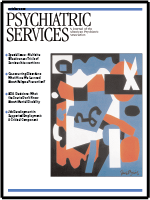Sample for Validation of Jail Mental Health Screen
In Reply: Dr. Dillon highlights a point that we made in a footnote to our table. As he correctly notes, the reported results for sensitivity and specificity were calculated on the validation sample and not weighted back to the jail admissions during the study period at the four jails. It did not seem to us that weighting back to the full admission sample was the most useful approach for data presentation. Realizing that some readers would want to calculate sensitivity and specificity, we did include them in the footnote. To be consistent with the approach taken in other studies, we chose not to weight the data in any way. If we had, the results would relate exactly to the admissions of the four jails studied but would not necessarily be generalizable to other U.S. jails. We intentionally included the raw data so that any jail could weight it back to their own detainees, as Dr. Dillon has done here for the four jails we studied.
The BJMHS was created to be a tool for jails to use in screening new inmates for mental illness. We presented data in a way that would permit jail administrators to make decisions based on their jail and not on the four jails we studied. Although Dr. Dillon's recalculation of sensitivity (down from 65.5 percent), specificity (up from 76.5 percent), and overall "hit rate" (up from 73.5 percent) are correct for the four jails, these figures would change for other jails depending on the number of persons with mental illness.
What would not change is the calculation of a false-negative rate (inmates whom we classified as not symptomatic and who received diagnoses by use of the SCID as having a mental illness) of 14.6 percent for the males in the study and a false-positive rate of 48.6 percent. These are the most telling results and the numbers that jail administrators should use when making decisions on whether to use the BJMHS. Whether the accuracy rate is 73.5 percent for the validation data or 82.1 percent for the data weighted for the four jails, we still believe that the BJHMS is the best tool currently available.



